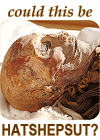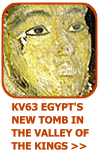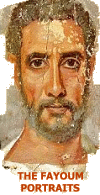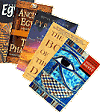|
|
|

Topics in this section: work and trade | leisure activities | hunting and fishing | food and drink | health and wellbeing | dress
The Ancient Egyptians lived life to the full. At festivals and parties they feasted and drank, and were entertained by singers, dancers and musicians. Children played out in the sun, while adults enjoyed hunting, fishing and board games, such as senet.
Let the music play ...
Egyptians held feasts to celebrate births, marriages and religious festivals, or simply to entertain friends. The wealthy enjoyed holding dinner parties, where cooks would prepare a huge meals, flavoured with imported herbs and spices. Dressed in their best clothes, guests sat on chairs or on cushions on the floor, eating and drinking large quantities of wine.
 |
Party scenes show how much the Egyptians liked music and dance. This well known banquet scene is from a tomb of a wealthy nobleman named Nebamun. The tomb was built around 1400 BC in Thebes. One woman plays a double flute whilst others clap along and dance. |
| An integral part of both religious and secular festivals, dancers and musicians would enliven the festivities with harps, lyres and lutes, the oboe (most often played by women) the double flute, and drums to keep up beat of the music. Dancers and musicians were usually employed by a temple, or could work as freelancers. |
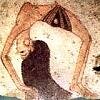 |
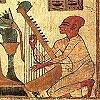 |
Playing the game ...
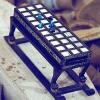 |
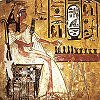 |
Senet or "passing" was an extremely popular game among ancient Egyptians, royalty as well as laymen. The gaming board itself had 30 spaces on the rectangular board. Tutankhamun was buried with four senet boards in his tomb. A famous painting from the tomb of Nefetari, the wife of Ramesses II, shows her playing senet.
|
The game developed to symbolise the passage of the deceased through the netherworld. This derived from the game's main goal as the two players would each try to advance their own pieces, whilst blocking or eliminating those of the opponent's as determined by the sticks or dice thrown before each move.
One of the earliest Egyptian board games was the snake game. The board wass in the shape of a coiled snake, and players would begin at the tip of the tail and move their counter towards the snake's head at the centre.
| The Egyptians favoured organised sporting events, such as boxing and fencing with sticks. Marathon races were important events, particularly during celebrations commemorating a new pharaoh. One of the rituals of these celebrations was to hold a marathon run by the pharaoh around the temples before spectators to reveal his physical strength and his ability to rule using his bodily and mental capabilities. |
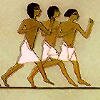 |
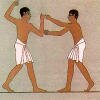 |
Childs play ...
| In the warm Egyptian climate, children spent a lot of time outdoors, swimming, dancing, riding donkeys and enjoying games of leap-frog and tug-of-war. They played with dolls, toy animals, and pets such as cats, birds and monkeys. Children spun pottery tops and played with balls made of either papyrus, cloth and leather. |
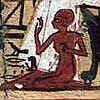 |
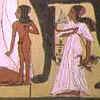 |
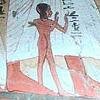 |
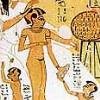 |
Children are portrayed in Egyptian art as generally naked, either near to, or with their parents, and are sometimes shown sucking their right index finger. The sidelock of youth was perhaps the most obvious childhood feature, a shaved head with an "s" shaped lock, often braided on the right side of the head. The "s" shape also represented the hieroglyph symbol for youth.
|
| These carved wooden toys would have been pulled along by a string. Pulling the string on the wooden cat would have made its mouth open and close. Other ancient animal toys have glass eyes, movable legs and arms and tails that wag. Simple rag dolls were also a popular choice. |
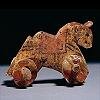 |
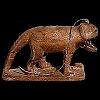 |
Figures and drawings of important personages are usually drawn several times larger than their children and servants, reflecting the hierarchic structure of both family and society. Children are therefore represented in Egyptian art as several times smaller in scale than their parents, and the younger the child, the smaller they are.
Hunting and fishing in Ancient Egypt >>
|
|
|





